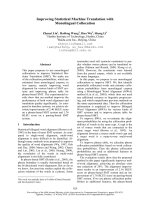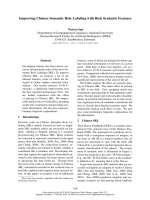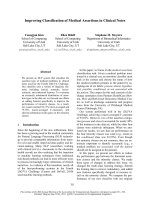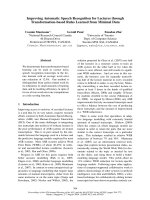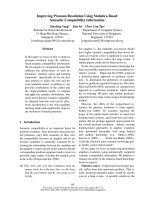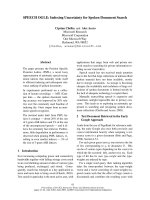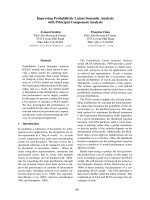Báo cáo khoa học: "Improving Automatic Indexing through Concept Combination and Term Enrichment" ppt
Bạn đang xem bản rút gọn của tài liệu. Xem và tải ngay bản đầy đủ của tài liệu tại đây (421.44 KB, 5 trang )
Improving Automatic Indexing through Concept Combination
and Term Enrichment
Christian Jacquemin*
LIMSI-CNRS
BP 133, F-91403 ORSAY Cedex, FRANCE
j acquemin@limsi, fr
Abstract
Although indexes may overlap, the output of
an automatic indexer is generally presented as
a fiat and unstructured list of terms. Our pur-
pose is to exploit term overlap and embed-
ding so as to yield a substantial qualitative
and quantitative improvement in automatic in-
dexing through concept combination. The in-
crease in the volume of indexing is 10.5% for
free indexing and 52.3% for controlled indexing.
The resulting structure of the indexed corpus is
a partial conceptual analysis.
1 Overview
The method, proposed here for improving au-
tomatic indexing, builds partial syntactic stru-
ctures by combining overlapping indexes. It is
complemented by a method for term acquisition
which is described in (Jacquemin, 1996). The
text, thus structured, is reindexed; new indexes
are produced and new candidates are discove-
red.
Most NLP approaches to automatic indexing
concern free indexing and rely on large-scale
shallow parsers with a particular concern for
dependency relations (Strzalkowski, 1996). For
the purpose of controlled indexing, we exploit
the output of a NLP-based indexer and the stru-
ctural relations between terms and variants in
order to (1) enhance the coverage of the in-
dexes, (2) incrementally build an
a posteriori
conceptual analysis of the document, and, (3)
interweave controlled indexing, free indexing,
and thesaurus acquisition. These 3 goals are
achieved by CONPARS (CONceptual PARSer),
presented in this paper and illustrated by Fi-
gure 1. CONPARS is based on the output of
* We thank INIST-CNRS for providing us with thesauri
and corpora in the agricultural domain and AFIRST
for
supporting this research through the SKETCHI project.
a part-of-speech tagger for French described in
(Tzoukermann and Radev, 1997) and FASTR,
a controlled indexer (Jacquemin et al., 1997).
All the experiments reported in this paper are
performed on data in the agricultural domain:
[AGRIC] a 1.18-million word corpus, [AGRO-
VOC] a 10,570-term controlled vocabulary, and
[AGR-CAND] a 15,875-term list acquired by
ACABIT (Daille, 1997) from [AGRIC].
Augmented
indexing
Figure 1: Overall Architecture of CONPARS
2
Basic Controlled Indexing
The preprocessing of the corpus by the tag-
ger yields a morphologically analyzed text,
with unambiguous syntactic categories. Then,
the tagged corpus is automatically indexed by
FASTR which retrieves occurrences of multi-
word terms or variants (see Table 1).
595
Table 1: Indexing of a Sample Sentence
La variation mensuelle de la respiration du
sol et
ses rapports avec l'humiditd et la tempdrature du
sol ont dtd analysdes dans le sol super]iciel d'une
for~t tropicale.
(The
monthly variation of the respi-
ration of the soil and its connections with the mois-
ture and the temperature of the soil have been ana-
lyzed in the surface soil of a tropical forest.)
il 007019
Respiration du sol
Occurrence
respiration du sol
(respiration of
the soil)
i2 002904
Sol de for~t
Embedding2
so_.__l superficiel d'une ]or~t
(surf. soil of a forest)
i3 012670
Humiditd du
sol
Coordination1
humiditd et la tempdrature du
sol
(moisture and
the temperature of the soil)
i4 007034
Tempdrature du sol
Occurrence
tempdrature du sol
(temperature of
the soil)
i5 007035
Analyse de sol
VerbTransfl
analysdes clans le sol
(analyzed in
the soil)
i6 007809
For~t tropicale
Occurrence
for~t tropicale
(tropical forest)
Each variant is obtained by generating term
variations through local transformations com-
posed of an input lexico-syntactic structure
and a corresponding output transformed struc-
ture. Thus, VerbTransfl is a verbalization which
transforms a Noun-Preposition-Noun term into
a verb phrase represented by the variation pat-
tern
V 4 (Adv ? (Prep ? Art [ Prep) A ?)
N3:1
VerbTransfl( N1 Prep2 N3 ) (1)
= V4 (Adv ? (Prep ? Art J Prep) A ?) N3
{MorphFamily(N1) = MorphFamily(V4)}
The constraint following the output structure
states that V4 belongs to the same morphologi-
cal family as N1, the head noun of the term.
VerbTransfl
recognizes
analys~es[v] dans[prep]
le[nrt]
sOl[N]
(analyzed in the soil) as a variant
of
analyse[N]
de[Prep]
sol[N]
(soil analysis).
Six families of term variations are accounted
for by our implementation for French: coordina-
tion, compounding/decompounding, term em-
bedding, verbalization (of nouns or adjectives),
nominalization (of nouns, adjectives, or verbs),
and adjectivization (of nouns, adjectives, or
verbs). Each index in Table 1 corresponds to
1The following abbreviations are used for the catego-
ries: V = verb, N = noun, Art = article, hdv adverb,
Conj = conjunction, Prep preposition, Punc punc-
tuation.
a unique term; it is referenced by its identifier,
its string, and a unique variation of one of the
aforementioned types (or a plain occurrence).
3 Conceptual Phrase Building
The indexes extracted at the preceding step are
text chunks which generally build up a correct
syntactic structure: verb phrases for verbaliza-
tions and, otherwise, noun phrases. When over-
lapping, these indexes can be combined and re-
placed by their head words so as to condense
and structure the documents. This process is
the reverse operation of the noun phrase decom-
position described in (Habert et al., 1996).
The purpose of automatic indexing entails the
following characteristics of indexes:
• frequently, indexes overlap or are embed-
ded one in another (with [AGR-CAND],
35% of the indexes overlap with another
one and 37% of the indexes are embed-
ded in another one; with [AGROVOC], the
rates are respectively 13% and 5%),
• generally, indexes cover only a small fra-
ction of the parsed sentence (with [AGR-
CAND], the indexes cover, on average, 15%
of the surface; with [AGROVOC], the ave-
rage coverage is 3%),
• generally, indexes do not correspond to
maximal structures and only include part
of the arguments of their head word.
Because of these characteristics, the construc-
tion of a syntactic structure from indexes is like
solving a puzzle with only part of the clues, and
with a certain overlap between these clues.
Text Structuring
The construction of the structure consists of the
following 3 steps:
Step 1. The syntactic head of terms is deter-
mined by a simple noun phrase grammar of the
language under study. For French, the following
regular expression covers 98% of the term struc-
tures in the database [AGROVOC] (Mod is any
adjectival modifier and the syntactic head is the
noun in bold face):
Mod* N N ? (Mod I (Prep Art ? Mod* N N ? Mod*))*
The second source of knowledge about synta-
ctic heads is embodied in transformations. For
596
instance, the syntactic head of the verbalization
in (1) is the verb in bold typeface.
Step 2. A partial relation between the indexes
of a sentence is now defined in order to rank
in priority the indexes that should be grouped
first into structures (the most deeply embedded
ones). This definition relies on the relative spa-
tial positions of two indexes i and j and their
syntactic heads
H(i)
and H(j):
Definition 3.1 (Index priority)
Let i and j
be two indexes in the same sentence. The rela-
tive priority ranking of i and j is:
i~j ¢~ (i=j) V(H(i)=n(j)AiCj)
V (H(i)¢H(j)AH(i)ej A n(j)¢_i)
This relation is obviously reflexive. It is nei-
ther transitive nor antisymmetric. It can, howe-
ver, be shown that this relation is not cyclic for
3 elements:
i~j A jT~k =¢ -~(kT~i).
(This
property is not demonstrated here, due to the
lack of space.)
The linguistic motivations of Definition 3.1
are linked to the composite structure built at
Step 3 according to the relative priorities stated
by T~. We now examine, in turn, the 4 cases of
term overlap:
1. Head embedding: 2 indexes i and j, with
a common head word and such that i is
embedded into j, build a 2-level structure:
H(i) H(i)
H(i)
This structuring is illustrated by
nappe
d'eau
(sheet of water) which combines
with
nappe d'eau souterraine
(underground
sheet of water) and produces the 2-level
structure
[[nappe d'eau] souterraine]
([un-
derground ~ of water]]). (Head words
are underlined.) In this case, i has a higher
priority than j; it corresponds to
(H(i) =
H(j) A i C_ j)
in Definition 3.1.
2. Argument embedding: 2 indexes i and j,
with different head words and such that the
head word of i belongs to j and the head
word of j does not belong to i, combine as
follows:
n(j) H(j) H(i)
14(0
This structuring is illustrated by
nappe
d'eau
which combines with
eau souter-
raine
(underground water) and produces
the structure
[nappe d~.eau souterraine]]
([sheet of [underground water.]]). Here, i
has a higher priority than j; it corresponds
to
(H(i) ~ H(j) A H(i) • j A g(j) ~ i)
in Definition 3.1.
3. Head overlap: 2 indexes i and j, with
a common head word and such that i
and j partially overlap, are also combi-
ned at Step 3 by making j a substructure
of i. This combination is, however, non-
deterministic since no priority ordering is
defined between these 2 indexes. There-
fore, it does not correspond to a condition
in Definition 3.1.
H(i)
In our experiments, this structure cor-
responds to only one situation: a head
word with pre- and post-modifiers such
as importante activitd
(intense activity)
and
activivtg de ddgradation mdtabolique
(activity of metabolic degradation).
With [-AGR-CAND], this configuration
is encountered only 27 times (.1% of
the index overlaps) because premodifiers
rarely build correct term occurrences in
French. Premodifiers generally correspond
to occasional characteristics such as size,
height, rank, etc.
4. The remaining case of overlapping indexes
with different head words and reciprocal in-
clusions of head words is never encounte-
red. Its presence would undeniably denote
a flaw in the calculus of head words.
Step 3. A bottom-up structure of the sentences
is incrementally built by replacing indexes by
trees. The indexes which are highest ranked by
597
the Step 2 are processed first according to the
following bottom-up algorithm:
1. build a depth-1 tree whose daughter nodes
are all the words in the current sentence
and whose head node is S,
2. for all the indexes i in the current sentence,
selected by decreasing order of priority,
(a) mark all the the depth-1 nodes which
are a lexical leaf of i or which are the
head node of a tree with at least one
leaf in i,
(b) replace all the marked nodes by a
unique tree whose head features are
the features of H(i), and whose depth-
1 leaves are all the marked nodes.
When considering the sentence given in
Table 1, the ordering of the indexes after Step 2
is the following: i2 > i5,
i6 > i2,
and
i4 > i3.
(They all result from the argument embedding
relation.) The algorithm yields the following
structure of the sample sentence:
f
la respiration et ses rapports avec l'humidit~ ont dt~ analvs~es
respiration du sol humidit~ et la temperature analys~es dans le sol
temperature du sol sol superficiel d'une for~t
for~t tropicale
Text Condensation
The text structure resulting from this algorithm
condenses the text and brings closer words that
would otherwise remain separated by a large
number of arguments or modifiers. Because of
this condensation, a reindexing of the structu-
red text yields new indexes which are not ex-
tracted at the first step.
Let us illustrate the gains from reindexing
on a sample utterance: l'dvolution au cours du
temps du sol et des rendements (temporal evo-
lution of soils and productivity). At the first
step of indexing, ~volution au cours du temps
(lit. evolution over time) is recognized as a va-
riant of dvolution dans le temps (lit. evolution
with time). At the second step of indexing, the
daughter nodes of the top-most tree build the
condensed text: l'dvolution du sol et des rende-
ments (evolution of soils and productivity):
1st step
l'~volution au cours du temps du sol el des rendements
2nd step
l'~volution du sol et des rendements
l'~volution au cours du temps
This condensed text allows for another index ex-
traction: dvolution du sol et des rendements, a
Coordination variant of dvolution du rendement
(evolution of productivity). This index was not
visible at the first step because of the additional
modifier au cours du temps (temporal). (Reite-
rated indexing is preferable to too unconstrai-
ned transformations which burden the system
with spurious indexes.)
Both processes text structuring, presented
here, and term acquisition, described in (Jac-
quemin, 1996) reinforce each other. On the
one hand, acquisition of new terms increases the
volume of indexes and thereby improves text
structuring by decreasing the non-conceptual
surface of the text. On the other hand, text
condensation triggers the extraction of new in-
dexes, and thereby furnishes new possibilities
for the acquisition of terms.
4 Evaluation
Qualitative evaluation: The volume of in-
dexing is characterized by the surface of the
text occupied by terms or their combinations
we call it the conceptual surface. Figure 2
shows the distribution of the sentences in re-
lation to their conceptual surface. For instance,
in 8,449 sentences among the 62,460 sentences
of [AGRIC], the indexes occupy from 20 to 30%
of the surface (3rd column).
This figure indicates that the structures built
from free indexing are significantly richer than
those obtained from controlled indexing. The
number of sentences is a decreasing exponen-
tial function of their conceptual surface (a linear
function with a log scale on the y axis).
Figure 3 illustrates how the successive steps
of the algorithm contribute to the final size of
the incremental indexing. For each mode of
598
10 s
~ 10 4
N
10 3
~ 10 2
~ 10 I~
10 0
0
Free indexing
Controlled indexing
10 20 30 40 50 60 70 80 90 100
% of
conceptual suface
Figure 2: Conceptual Surface of Sentences
Table 2: Increase in the volume of indexing
Acquisition
Condensation Total
Controlled 49.3% 3.0% 52.3%
Free 5.8% 4.7%
10.5%
indexing two curves are plotted: the phrases
resulting from initial indexing and from rein-
dexing due to text condensation (circles) and
the phrases due to term acquisition (asterisks).
For instance, at step3, free indexing yields 309
indexes and reindexing 645. The corresponding
percentages are reported in Table 2.
The indexing with the poorest initial volume
(controlled indexing) is the one that benefits
best from term acquisition. Thus, concept com-
bination and term enrichment tend to compen-
sate the deficiencies of the initial term list by
extracting more knowledge from the corpus.
10 5,
"~
10 4.
103
102
~. 10'
I0 ~
~ o
Free indexing
* Free acquisition
"' ~_._~.~ @
Controlled indexing
. "'-_. ~ * o Controlled
acquisition
2 3 4 5 6 7 8
# step
Figure 3: Step-by-step Number of Phrases
Qualitative evaluation: Table 3 indicates the
number of overlapping indexes in relation to
their type. It provides, for each type, the rate of
success of the structuring algorithm. This eva-
Table 3: Incremental Structure Building
Head Argument Total
embedding
embedding
Distribution
27.0% 73.0% 100%
# correct
128 346
474
Precision
79.0% 91.1% 87.5%
luation results from a human scanning of 542
randomly chosen structures.
5 Conclusion
This study has presented CONPARS, a tool
for enhancing the output of an automatic in-
dexer through index combination and term en-
richment. Ongoing work intends to improve the
interaction of indexing and acquisition through
self-indexing of automatically acquired terms.
References
B6atrice Daille. 1997. Study and implementa-
tion of combined techniques for automatic ex-
traction of terminology. In J. L. Klavans and
P. Resnik, ed.,
The Balancing Act: Combi-
ning Symbolic and Statistical Approaches to
Language,
p. 49-66. MIT Press, Cambridge.
Benoit Habert, Elie Naulleau, and Adeline Na-
zarenko. 1996. Symbolic word clustering for
medium size corpora. In
Proceedings of CO-
LING'96,
p. 490-495, Copenhagen.
Christian Jacquemin, Judith L. Klavans, and
Evelyne Tzoukermann. 1997. Expansion of
multi-word terms for indexing and retrieval
using morphology and syntax. In
Proceedings
of ACL-EACL'97,
p. 24-31.
Christian Jacquemin. 1996. A symbolic and
surgical acquisition of terms through varia-
tion. In S. Wermter, E. Riloff, and G. Sche-
ler, ed.,
Connectionist, Statistical and Symbo-
lic Approaches to Learning for NLP,
p. 425-
438. Springer, Heidelberg.
Tomek Strzalkowski. 1996. Natural language
information retrieval.
Information Processing
~J Management,
31(3):397-417.
Evelyne Tzoukermann and Dragomir R. Radev.
1997. Use of weighted finite state transducers
in part of speech tagging. In A. Kornai, ed.,
Extended Finite State Models of Language.
Cambridge University Press.
599

